

Discovering Faunal SuccessionWhen Smith was little, fossil brachiopods may have been nothing more than marbles, and he might have forgotten fossils altogether had he lived at a different time. But he grew up when the Industrial Revolution focused England’s attention on the compressed, hardened remains of ancient swamps—coal. Smith wasn’t wealthy and his opportunities for formal education were limited, but he was bright, and he found work as a surveyor when he was just 18. His work required him to visit numerous coal mines, and his trips down the mineshafts showed him that rock layers occurred in predictable sequences. He started to suspect that these sequences extended across England. |
|||
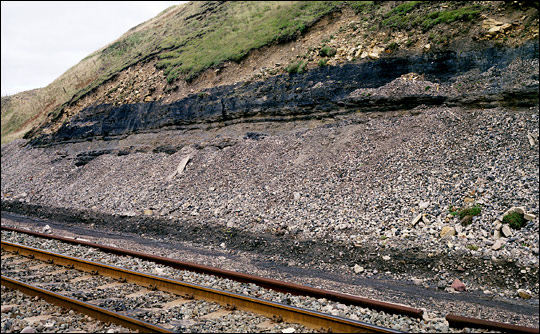 | |||
Smith’s work gave him an opportunity to test his hypothesis. To take advantage of fossil fuels, England’s industrialists didn’t just have to dig up coal, they had to transport it efficiently. Before settling on train transport, England experimented with canals. As a surveyor for many of these canals, Smith traveled some 10,000 miles per year, mapping strata as he went. Digging a canal meant slicing through rock layers across miles of landscape, and the cross-sectional views of strata allowed Smith to confirm the order of rock layers across wide distances. But not all of Smith’s research was straightforward. Sometimes it was perplexing. |
Smith’s first exposure to rock strata came while he worked surveying and draining mines in southwest England. The sequence of coal seams and intervening rock layers in one mine were repeated in mines across the region. Smith discovered that a similar sequence is repeated across all of England, as seen in this exposed coal seam near Providence Bay, Parton. (Reproduced with the permission of the British Geological Survey ©1989 NERC. All rights reserved.) | ||
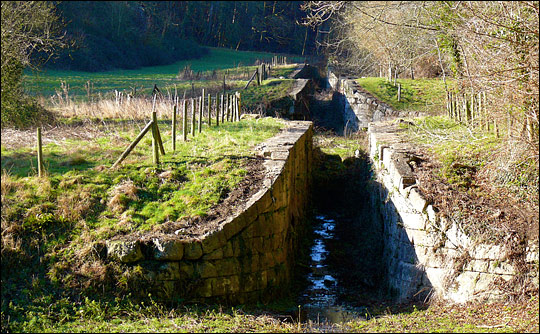 | |||
He was confident that rock strata—now tilted, or dipped—had first been deposited in horizontal layers, and to walk past them was to move forward or backward in the rock sequence. But he couldn’t know the details of the processes that had fashioned England’s landscapes. When he found a sandy deposit in one place and a similar sandy deposit elsewhere, he had to ask whether they were part of the same rock formation laid down at the same time. Smith needed a way to tell layers apart, no matter where in England they were located. As he accumulated observations of strata and fossils in mines and canals, he found the key to telling the layers apart: their fossils were different. |
While working as surveyor for the Somerset Coal Canal, Smith was able to track rock layers across the landscape. He used this experience to flesh out his ideas on the ordering of strata that he first gleaned from the coal mines. This sequence of locks is one of the few remaining traces of the abandoned canal. (Photograph ©2008 gilest.) | ||
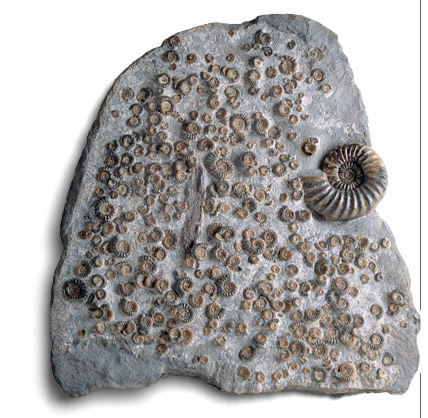 |
One key to identifying sedimentary rock layers is fossils. At any point in time a distinct group of species exist, and the remains they leave behind form a unique assemblage of fossils. This collection of ammonites was found in the English Lower Lias Formation. (Photograph courtesy of the Alfred M. Bailey Archives at the Denver Museum of Nature & Science.) | ||
Smith noticed that two beds of rock might contain several identical fossil species, but one or two species would vary. These subtle differences between fossil groups, or assemblages, enabled Smith to differentiate rock strata that appeared otherwise identical. In Strata Identified by Organized Fossils, published from 1816 to 1819, he recalled: Fossil Shells had long been known amongst the curious, collected with care, and preserved in their cabinets, along with other rarities of nature, without any apparent use. That to which I have applied them is new, and my attention was first drawn to them, by a previous discovery of regularity in the direction and dip of the various Strata in the hills around Bath; for it was the nice distinction which those similar rocks required, which led me to the discovery of organic remains peculiar to each Stratum. This was the finding that became known as Smith’s Principle of Faunal Succession. Today it appears in geology textbooks the world over. Successes, Failures, and Final YearsBesides developing the Principle of Faunal Succession, Smith also undertook the most ambitious geologic map-making project of his time: a geologic map of all of England. Instead of mapping just the surface, he had to map what lay below it, translating three dimensions into two. Inspired by an agricultural map that used color-coding to convey an added layer of information, he published A Map of Five Miles round the City of Bath in 1799, one of the world’s first geologic maps. After publishing his Bath map, he began to think on a grander scale. Although friends encouraged him to hurry and publish before anyone else, assorted setbacks delayed the project for years. Worse, Smith was a procrastinator. He eventually triumphed over the slower part of his nature, and on August 1, 1815, he published A Delineation of the Strata of England and Wales with a part of Scotland. On a scale of 5 miles per inch, the map measured 6 feet by 8 feet 6 inches. Like the agricultural map he had seen years before, this map was colored, with color gradations indicating where one rock formation gave way to the next. Earlier geologists had mapped rock formations and even used fossils to identify rocks, but Smith’s was the first map to depict so many rock formations over such a large area. |
|||
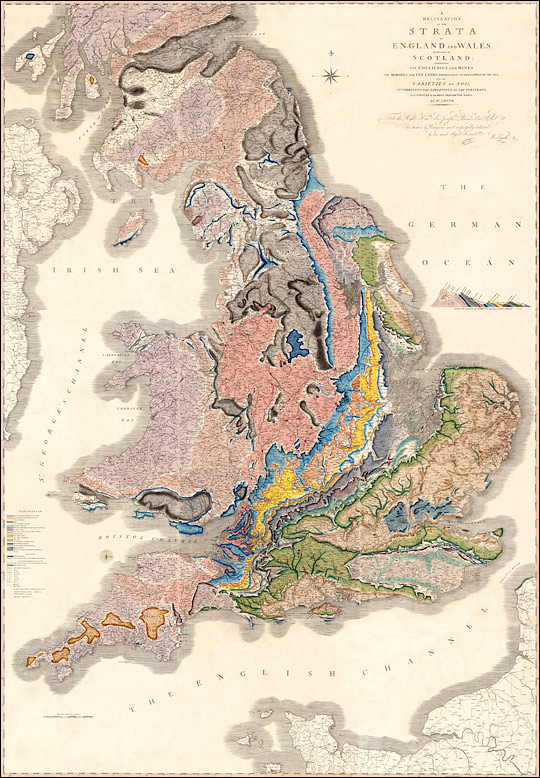 | |||
Smith produced this impressive work on his own, often using his own money, perhaps to his later regret. Although he had enjoyed steady employment in his early surveying days, he later freelanced, earning an unsteady income. He also began acquiring pricey properties: a country estate, office space in the fashionable resort town of Bath, a four-storey home in London. By the time his map was finally published, he was selling his treasured fossil collection to the British Museum to raise cash. Painful as the fossil sale was, it only postponed the inevitable. On June 11, 1819, Smith began an 11-week sentence in King's Bench, one of London's notorious debtors’ prisons. His own extravagance probably wasn’t the only explanation for Smith’s financial problems. His stint in debtors’ prison might have been avoided if his map had sold better, and it likely would have, had it not been eclipsed by a competitor. George Bellas Greenough, gentleman geologist and president of the Geological Society of London, was the driving force behind the map that challenged Smith’s. Thanks to the unwitting assistance of an associate of Smith’s, Greenough obtained access to Smith’s manuscripts, which he used with little acknowledgement. Backed by the prestige and resources of the Geological Society, Greenough improved slightly upon Smith’s work, and because his map was priced lower, it undercut Smith’s sales. After his release from debtors’ prison, Smith took a series of odd jobs throughout northern England, teaching courses for local philosophical societies in between. In Scarborough, he helped establish the city museum, including designing its rotunda. His design allowed fossils to be displayed along the outer walls in the same order in which they are naturally found in strata, giving visitors ascending the museum’s spiral staircase a visual guide to the history of life on Earth. |
Published in 1815, Smith’s Geological Map of England and Wales and Part of Scotland was the first geologic map to cover such a large area in such fine detail. The map used hand-applied color gradations to show where one formation gave way to the next, conveying three dimensions of information on a two-dimensional surface. He distinguished different rock layers partly by examining their different fossil assemblages. (Reproduced by permission of the British Geological Survey. ©NERC. All rights reserved. IPR/100-28DR. To obtain a copy of the map, visit the BGS online shop.) | ||
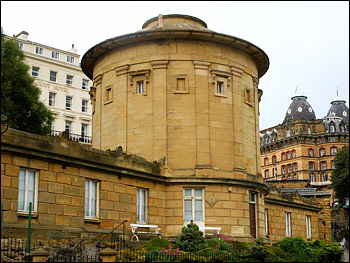
After years of moving from job to job, Smith found steady employment and a fairly permanent home as a land steward on a large estate. Around that time, he began to receive overdue accolades for his work. In 1831, the Geological Society, which had refused him membership earlier, awarded him the Wollaston Medal, its highest honor. He received an honorary doctorate of letters from Trinity College, Dublin. And perhaps most practical, he received a lifetime pension from King William IV. William Smith died on August 28, 1839, after a brief illness. His final years had been happy ones in which he enjoyed the financial stability and professional recognition he had long awaited. In March 2007, a restored copy of his geologic map of England was unveiled—next to a map of Greenough’s—in the East staircase of the Burlington House, current home to the Geological Society of London. |
Late in life, Smith helped plan the Rotunda Museum in Scarborough. The museum originally held displays of the sequence of rock strata underlying the east coast of England. (Photograph ©2006 Martin Brewster.) | ||